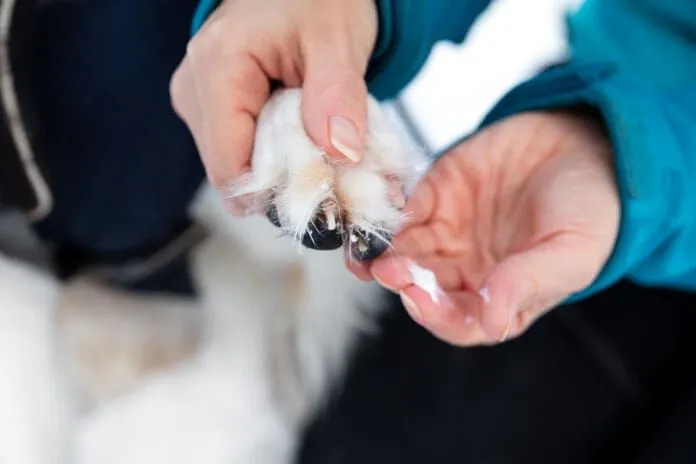Your dog’s paw pads are essential, acting as natural cushions and protectors against various terrains and weather conditions. However, these pads can become damaged or strained due to harsh weather, rigorous activities, and certain health issues. This is where the Best Ointment For Dog Paws can make a significant difference.
 Dog paw balm helps protect dog paws from the environment.Paw balm helps protect dog paws from environmental factors, ensuring their health and resilience.
Dog paw balm helps protect dog paws from the environment.Paw balm helps protect dog paws from environmental factors, ensuring their health and resilience.
Is Paw Balm Necessary for Your Dog?
Generally, paw balm for dogs serves two primary purposes: to moisturize pads that are excessively dry and hardened, and to shield the pads from conditions that can lead to dryness and cracking. While not all dogs require regular application, it can be a valuable aid in specific circumstances.
It’s important to note that paw balms are not a substitute for treating paw infections or deep cuts, nor do they offer complete protection from extreme weather. Instead, they provide an additional layer of defense to help the pads function optimally.
Dealing with Ice and Snow
Winter can be particularly harsh on dog paws, causing dryness and cracking. This is especially true for senior dogs, who may benefit significantly from paw balm to maintain pad flexibility and improve grip—a great advantage for older dogs navigating slippery surfaces.
Younger, active dogs also face challenges in winter, as their paws are exposed to ice, snow, and de-icing chemicals that can dry out the pads. Snow and ice can also accumulate between the toes, causing discomfort. Paw balms help keep the pads moisturized, preventing snow from sticking and easing your dog’s outdoor playtime.
Protecting Against Hot Surfaces
Hot pavements and rocky trails can dehydrate your dog’s paw pads, particularly if they frequently walk on hard surfaces. Regular use of paw balm can prevent cracking and offer slight heat protection.
When temperatures rise, try to walk your dog on grass whenever possible to prevent burns. If hot surfaces are unavoidable, keep your dog moving to reduce prolonged contact with the ground. Consider using protective dog booties if extended exposure to hot surfaces is expected.
Navigating Rough Terrain
Many dogs love running and playing outdoors, but rough terrain can damage their paw pads. Abrasions, cracks, and small cuts can occur from running on hard surfaces or encountering gravel.
 Dog paw balm helps protect dog paws from the environment.Running on rough terrain can cause damage to a dog’s paw pads, making paw balm essential for protection.
Dog paw balm helps protect dog paws from the environment.Running on rough terrain can cause damage to a dog’s paw pads, making paw balm essential for protection.
Applying paw balm can help maintain the softness and resilience of the pads, offering some protection if your dog is about to run on hard ground for the first time in a while or is likely to encounter rough terrain.
Addressing Hyperkeratosis
Hyperkeratosis, a condition causing excessive keratin production, often affects the paw pads and nose. While keratin is essential for paw durability, overproduction can lead to problems.
Dogs with hyperkeratosis may appear to have hairy growths on their feet, which are actually thick strands of keratin.
Breeds like Bulldogs, Pugs, Boxers, Cocker Spaniels, and Labrador Retrievers are more prone to this condition, though it can affect any breed. Hyperkeratosis can also be triggered by underlying immune conditions or diseases.
After a veterinarian rules out any underlying health issues, paw balm can soften these keratin growths, promoting natural wear during normal exercise. In severe cases, a vet may remove excess keratin and recommend paw balm to keep the paws moisturized.
Proper Application of Dog Paw Balm
When using paw balm for dogs, always follow your veterinarian’s instructions or the specific product guidelines. However, here are some general application tips:
- If the balm is firm, warm it in your hand to soften it before applying a small amount to the paw pad. Rub it in thoroughly.
- Use sparingly! The balm should absorb into the pad without leaving a wet, sticky residue.
- Ensure the entire paw pad is covered.
- To prevent snow buildup, apply the balm between the toes as well.
- Apply paw balm as a preventive measure before activities likely to dry out the paws.
- If you notice any cuts, sores, or irritation, discontinue use and consult your veterinarian.
Choosing the Best Dog Paw Balms
Finding the best ointment for dog paws involves considering several factors, including ingredients, reviews, and your dog’s specific needs. Look for balms with natural ingredients like shea butter, coconut oil, and beeswax, as these tend to be gentle and effective. Always ensure that the balm is safe for your dog if ingested, as they are likely to lick their paws after application.
